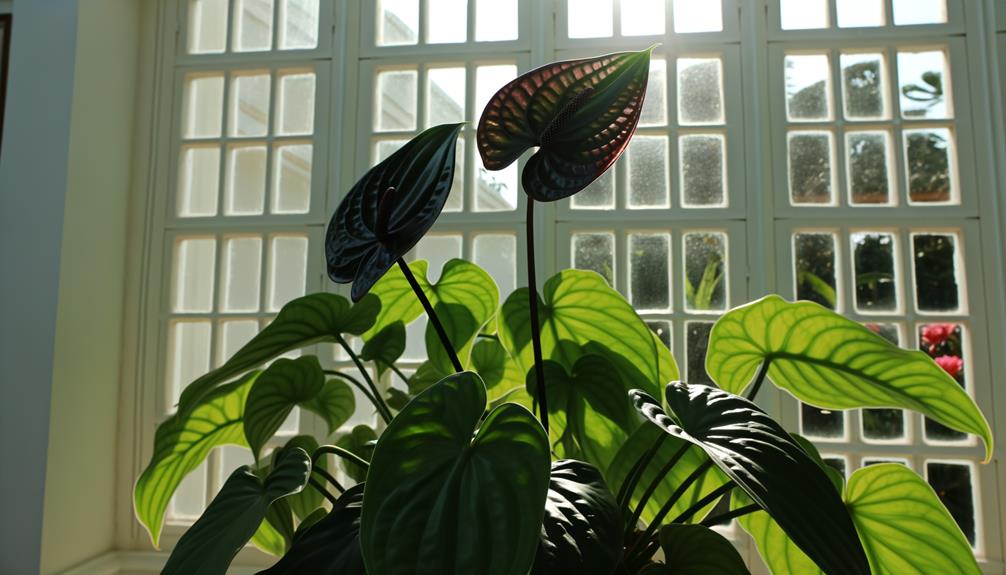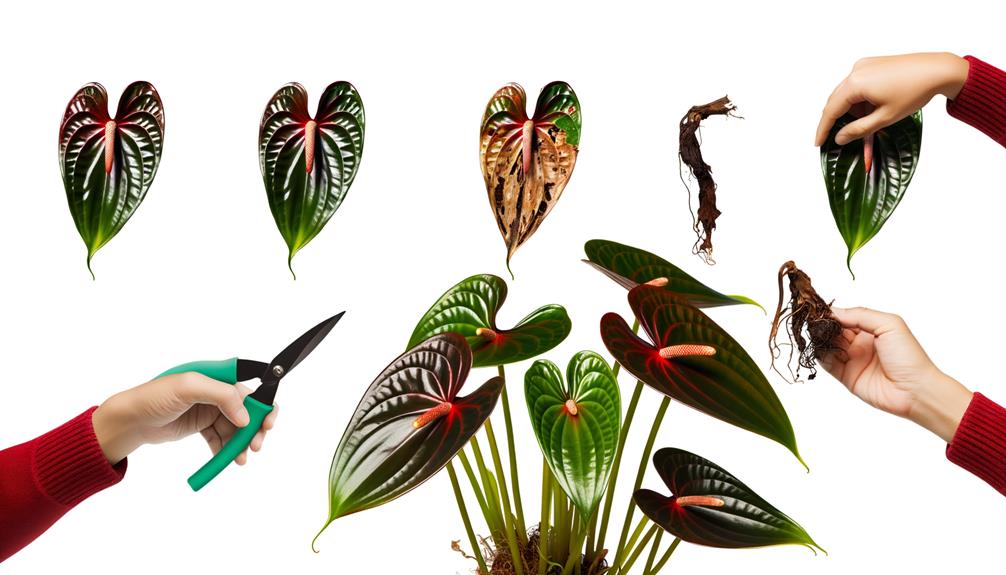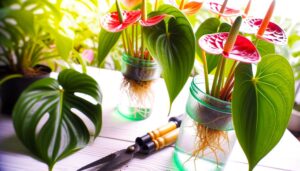Caring for Queen Anthurium Dark Form: Comprehensive Guide
To care for your Queen Anthurium Dark Form, place it in bright, indirect light, preferably near east or north-facing windows. Water when the top inch of soil is dry, using filtered or rainwater.
Your pot should have drainage holes to prevent standing water. Choose a well-ventilated mix of orchid bark, peat moss, perlite, and activated charcoal, repotting every two years.
Maintain temperatures between 65-80°F and humidity levels at 70-80%, using a humidifier if needed. Address yellowing leaves, root rot, and pests promptly with proper treatments.
For detailed strategies and expert tips, continue to learn more about each care aspect.

Key Takeaways
- Place the plant in bright, indirect light to avoid direct sunlight exposure.
- Water with filtered or rainwater only when the top inch of soil is dry.
- Use a well-ventilated potting mix containing orchid bark, peat moss, and perlite.
- Maintain a temperature range of 65-80°F and humidity levels at 70-80%.
- Treat yellowing leaves and root rot promptly by repotting and ensuring good air circulation.
Optimal Lighting Conditions

To secure your Queen Anthurium Dark Form thrives, place it in bright, indirect light to mimic its natural tropical habitat.
Direct sunlight can scorch its leaves, so avoid positioning it in a spot where it gets direct sun exposure. East or north-facing windows work best.
If using artificial lighting, opt for full-spectrum grow lights and position them about 12 to 18 inches above the plant. Rotate your plant every few weeks to secure even light distribution, promoting balanced growth.
Be vigilant about observing the plant’s response; yellowing leaves may indicate excessive light, while elongated, leggy growth suggests insufficient light. This precise lighting strategy will support the Anthurium’s unique, dark foliage, allowing it to flourish without constraints.
Watering Techniques
Now that you’ve optimized the lighting conditions, make certain your Queen Anthurium Dark Form receives the appropriate amount of water by maintaining consistently moist but not waterlogged soil.
Use these expert techniques:
- Watering Schedule: Water your plant when the top inch of soil feels dry. Consistency is key.
- Water Quality: Use filtered or rainwater to avoid mineral buildup, which can harm the plant.
- Drainage: Guarantee the pot has sufficient drainage holes to prevent root rot.
Avoid letting the plant sit in standing water, which can lead to fungal issues. Instead, aim for even moisture distribution throughout the soil.
Regularly check soil moisture levels using a moisture meter for precision. By following these techniques, your Queen Anthurium Dark Form will thrive.
Soil and Potting Mix

Choosing the correct soil and potting mix is crucial for providing your Queen Anthurium Dark Form with optimal nutrient absorption and drainage.
Opt for a well-ventilated, chunky mix to replicate its natural epiphytic habitat. Combine equal parts orchid bark, peat moss, and perlite. This blend guarantees excellent drainage while maintaining sufficient moisture.
Avoid heavy, compact soils that can result in root rot. Incorporating activated charcoal can enhance aeration and prevent fungal growth.
Select a pot with drainage holes to avoid waterlogging. Repotting every two years in fresh mix revitalizes soil structure and nutrient availability.
Enhance your plant’s health by ensuring the potting mix remains airy and nutrient-rich, promoting vigorous growth and lush foliage.
Temperature and Humidity
Maintaining an ideal temperature range of 65-80°F and high moisture levels around 70-80% is vital for the thriving growth of your Queen Anthurium Dark Form.
To achieve this, you’ll need to create a controlled environment. Use a hygrometer to monitor moisture levels and a digital thermometer for accurate temperature readings.
- Climate control: Position your plant away from drafts, air conditioners, and heating vents.
- Moisture solutions: Utilize a humidifier, pebble tray, or regular misting to maintain desired moisture.
- Temperature consistency: Guarantee stable temperatures by avoiding sudden fluctuations that can stress your plant.
Common Issues and Solutions

When caring for your Queen Anthurium Dark Form, you’ll likely encounter common issues such as yellowing leaves, root rot, and pest infestations, each requiring prompt and specific interventions to safeguard your plant’s health.
For yellowing leaves, reduce watering frequency and guarantee proper drainage. Root rot necessitates repotting in well-draining soil and trimming rotten roots. Combat pest infestations like spider mites and aphids with neem oil or insecticidal soap, applying directly to affected areas.
Ensure adequate air circulation and refrain from over-fertilization to prevent future problems. Monitoring your plant’s conditions closely and adjusting care routines accordingly will help maintain its lush, dark foliage.
Prioritize these interventions to enjoy a thriving Queen Anthurium Dark Form, free from common ailments.
Conclusion
Caring for your Queen Anthurium Dark Form is like conducting a symphony; each element must harmonize.
Guarantee bright, indirect light, consistent watering, well-draining soil, and a humid, warm environment.
By addressing common issues proactively, you’ll cultivate a thriving plant.
Remember, each care step is essential for the plant’s performance.
With precision and dedication, your Queen Anthurium will flourish, becoming the centerpiece of your botanical collection.
Keep this guide at hand for expert-level care.






